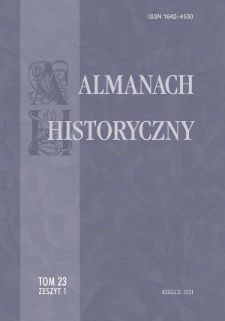Biblioteka Cyfrowa Uniwersytetu Jana Kochanowskiego udostępnia 13 097 obiektów cyfrowych
Obiekt
Tytuł: Protokoły parcelacyjne reformy rolnej z 1944–1945 w województwie kieleckim jako źródło do badań nad ziemiaństwem. Zarys problematyki
Twórca:
Tytuł publikacji grupowej:
Abstrakt:
Wytworzone w ciągu akcji parcelacyjnej protokoły przejęcia majątków na cele reformy rolnej to źródło, które wieloaspektowo opisuje gospodarkę folwarczną i niektóre przejawy życia ziemiaństwa. Ich wartość wynika z faktu, że były sporządzane wedle jednego formularza, co umożliwia porównanie danych dotyczących poszczególnych majątków na badanym terenie (woj. kieleckie). Jednak poziom szczegółowości nie jest taki sam, niekiedy widać mniejszą staranność w sporządzaniu protokołów. Z materiałów tych poznajemy stan gospodarki folwarcznej w przededniu likwidacji, tj. strukturę własności, wielkość i typ majątku oraz strukturę użytków rolnych, w nieco mniejszym stopniu strukturę upraw, stan pogłowia zwierząt hodowli i zapasów w majątkach. Dość szczegółowo skatalogowano inwentarz martwy / park maszynowy, dzięki któremu możemy poznać stopień mechanizacji produkcji. Dostajemy też na ogół staranne zestawienia dotyczące zabudowy dworskiej i folwarcznej oraz jego stanu technicznego, niekiedy też drobiazgowe opisy wyposażenia dworów. Dokumentują one także stan i strukturę zatrudnienia w majątkach. Protokoły poprzez regularność i bogactwo informacji to znakomite źródło do badania dziejów gospodarki folwarcznej i niektórych aspektów życia ziemiaństwa w jej schyłkowy okresie. Mogą one służyć jako dopełnienie dotychczasowych badań i ich pogłębienie. Masowość źródeł umożliwia prowadzenie badań komparatystycznych i syntetyzujących. Produced during in the action of land parcelling – the reports of the estates expropriation are a source that describes the farm’s economy and some displays of landowner’s life in many aspects. Their value seems to be due to the fact that they were prepared according to one form, which enables comparison of data on individual estates in the studied area (Kielce voivodeship). However, the level of detail is not the same, sometimes there is less diligence in preparing reports. The reports show the state of the grange economy on the eve of liquidation, i.e. the ownership structure, the size and type of property as well as the structure of arable land, to a lesser extent the structure of crops, the state of livestock, breeding and reserves on the estates. Dead stock was catalogued at some length, which allows us to know the degree of mechanization of production. We also get careful lists regarding court and manor buildings and its technical condition, sometimes also detailed descriptions of the equipment of the mansions. They also document the status and structure of employment in assets. Reports, due to their regularity and wealth of information, are an excellent source for studying the history of the grange economy and some aspects of the life of the landed gentry in its declining period. They can serve as a complement to existing research and their deepening. The mass of sources makes it possible to conduct comparative and synthesizing studies.
Miejsce wydania:
Opis fizyczny:
ISSN:
Wydawca:
Wydawnictwo Uniwersytetu Jana Kochanowskiego w Kielcach
Data wydania:
Identyfikator:
oai:bibliotekacyfrowa.ujk.edu.pl:4467 doi:10.25951/4411
Język:
Jest częścią:
Ma część:
Typ:
Prawa dostępu:
Format:
Kolekcje, do których przypisany jest obiekt:
- Biblioteka Cyfrowa Uniwersytetu Jana Kochanowskiego > Wydawnictwo Uniwersyteckie
- Biblioteka Cyfrowa Uniwersytetu Jana Kochanowskiego > Wydawnictwo Uniwersyteckie > Wydawnictwa ciągłe
- Biblioteka Cyfrowa Uniwersytetu Jana Kochanowskiego > Wydawnictwo Uniwersyteckie > Wydawnictwa ciągłe > „Almanach Historyczny”
Data ostatniej modyfikacji:
3 kwi 2025
Data dodania obiektu:
30 gru 2021
Liczba wyświetleń treści obiektu:
389
Liczba wyświetleń treści obiektu w formacie PDF
444
Wszystkie dostępne wersje tego obiektu:
https://bibliotekacyfrowa.ujk.edu.pl/publication/4411
Wyświetl opis w formacie RDF:
Wyświetl opis w formacie OAI-PMH:
Obiekty Podobne
Gapys, Jerzy Kowalczyk, Zbigniew Legieć, Jacek. Red.

